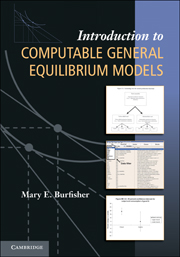Book contents
- Frontmatter
- Contents
- Text Boxes
- About This Book
- Acknowledgments
- 1 Introduction to Computable General Equilibrium Models
- 2 Elements of a Computable General Equilibrium Model
- 3 The CGE Model Database: A Social Accounting Matrix
- 4 Final Demand in a CGE Model
- 5 Supply in a CGE Model
- 6 Factors of Production in a CGE Model
- 7 Trade in a CGE Model
- 8 Taxes in a CGE Model
- 9 Conclusion: Frontiers in CGE Modeling
- Model Exercises
- Appendix
- Glossary
- Practice and Review Answer Key
- Model Exercise Answer Key
- References
- Author Index
- Subject Index
5 - Supply in a CGE Model
Published online by Cambridge University Press: 05 June 2012
- Frontmatter
- Contents
- Text Boxes
- About This Book
- Acknowledgments
- 1 Introduction to Computable General Equilibrium Models
- 2 Elements of a Computable General Equilibrium Model
- 3 The CGE Model Database: A Social Accounting Matrix
- 4 Final Demand in a CGE Model
- 5 Supply in a CGE Model
- 6 Factors of Production in a CGE Model
- 7 Trade in a CGE Model
- 8 Taxes in a CGE Model
- 9 Conclusion: Frontiers in CGE Modeling
- Model Exercises
- Appendix
- Glossary
- Practice and Review Answer Key
- Model Exercise Answer Key
- References
- Author Index
- Subject Index
Summary
In this chapter, we examine the supply side of an economy as represented in computable general equilibrium (CGE) models. The production data in the Social Accounting Matrix (SAM) depict the production process, in which firms combine intermediate inputs with factors of production to produce goods and services. We use these data to calculate input-output coefficients, and forward and backward linkages. CGE models break down the production technology into parts, depicting how subprocesses are nested within the overall production process. Within each nest, behavioral equations describe producers' efficiency-maximizing input demands and output levels, subject to their production technology. Export transformation functions, used in some CGE models, describe the allocation of production between domestic and export markets.
In 2009, the United States government offered financial assistance to its auto manufacturers to help them survive a deep recession and a freefall in consumer demand for cars. The bailout was controversial in part because the government seemed to be choosing to support a particular manufacturing industry. The government response was that the aid package not only helped save the jobs of autoworkers but also preserved jobs in the many industries that supply parts to the automakers and that sell and service autos. This part of the U.S. economic stimulus program built on the idea that an injection of support into one part of the economy would move in a circular flow to the rest of the economy, starting with the strong interindustry linkages between automakers and other manufacturing and service sectors.
Information
- Type
- Chapter
- Information
- Introduction to Computable General Equilibrium Models , pp. 105 - 131Publisher: Cambridge University PressPrint publication year: 2011
